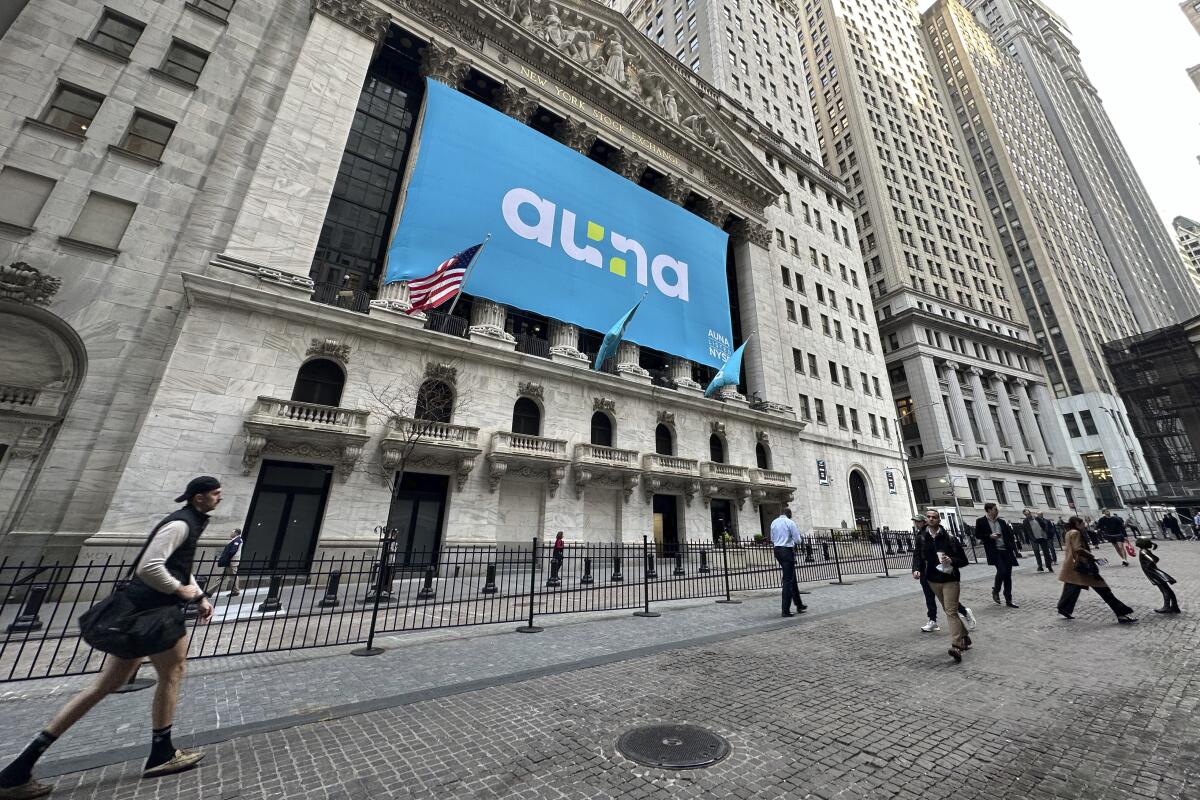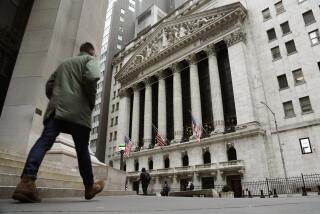Wall Street falls after hot inflation report burns hopes for a June rate cut

- Share via
NEW YORK — A washout on Wall Street sent stocks sinking Wednesday, as worries rose that what seemed like a blip in the battle to bring down inflation is turning into a troubling trend.
The S&P 500 dropped 0.9%, and the vast majority of stocks within the index fell. The Dow Jones industrial average tumbled 422 points, or 1.1%, and the Nasdaq composite sank 0.8%.
Treasury yields also leaped in the bond market, raising the pressure on the stock market, after a report showed inflation was hotter last month than economists expected. It’s the third straight report to suggest that progress on bringing high inflation down may be stalling. That hurts hopes that January’s and February’s disappointing inflation data may not have been as bad as they seemed because of some technical reasons.
“There are still embers of inflation here and there in the economy,” said Joe Davis, chief global economist at Vanguard.
For shoppers, that’s painful because of the potential for even higher prices at the store. For Wall Street, it raises fears that the Federal Reserve will hold back on delivering the cuts to interest rates that traders are craving and have been betting on.
The S&P 500 had already leaped more than 20% since Halloween in part on expectations that the Federal Reserve would lower its main interest rate, which is sitting at its highest level in more than two decades. Such cuts would relax the pressure on the economy and encourage investors to pay higher prices for stocks, bonds, cryptocurrencies and other investments.
But the Fed has been waiting for more evidence to show inflation is heading sustainably down toward its goal of 2%. After an encouraging cooling last year, the fear now is that inflation may be stuck after January’s, February’s and March’s inflation reports all came in hotter than expected, along with data on the economy generally.
“Two data points don’t make a trend, but maybe three do,” said Brian Jacobsen, chief economist at Annex Wealth Management.
“If we get one more reading like this, Fed chatter will shift from when to cut to whether to hike.”
Prices for bonds, gold and more fell immediately after the morning’s release of the inflation data.
The yield on the 10-year Treasury jumped to 4.54% from 4.36% late Tuesday and is back to where it was in November. The two-year yield, which moves more on expectations for Fed action, shot even higher and rose to 4.97% from 4.74%.
Traders sharply cut back on bets that the Fed could begin cutting rates in June. They now see just a 17% chance of that, down from nearly 74% a month ago, according to CME Group’s FedWatch tool.
Perhaps more important, traders shifted more bets toward the Fed cutting rates just twice over the course of this year. At the start of the year, they were forecasting six or more cuts through 2024.
High interest rates work to undercut inflation by slowing the economy and hurting investment prices. The fear is that rates left too high for too long can cause a recession.
Wall Street’s biggest losers on Wednesday included real estate investment trusts, utility companies and others whose stocks tend to be hurt most by high interest rates.
Real estate stocks in the S&P 500 fell 4.1% for the biggest loss by far among the 11 sectors that make up the index. That included a 6.1% drop for office owner Boston Properties and a 5.3% tumble for Alexandria Real Estate Equities.
Home builders also slumped because higher interest rates could chill the housing industry by making mortgages more expensive. D.R. Horton fell 6.4%, Lennar sank 5.8% and PulteGroup dropped 5.2%.
All told, the S&P 500 fell 49.27 points to 5,160.64. The Dow dropped 422.16 points to 38,461.51, and the Nasdaq composite fell 136.28 points to 16,170.36.
Critics had already been saying the U.S. stock market looked too expensive by several measures. They said either interest rates needed to fall or profits for companies needed to rally to make stock prices look more reasonable. The hope on Wall Street is that the resilient U.S. economy could help prop up profits, even if it does diminish hopes for rate cuts.
Big U.S. companies are lining up on the runway to say how much profit they earned during the first three months of the year, and Delta Air Lines helped kick off the reporting season by delivering better-than-expected results.
The airline said it’s seeing strong demand for flights around the world, and it expects the strength to continue through the spring. But it also refrained from raising its profit forecast for the full year. Its stock climbed as much as 4% during the morning before flipping to a loss of 2.3%.
The banking industry will soon take the spotlight in earnings season, with JPMorgan Chase and Wells Fargo among those reporting on Friday.
In stock markets abroad, indexes were mixed across much of Europe. In Asia, stocks rose 1.9% in Hong Kong but fell 0.7% in Shanghai after Fitch Ratings lowered its outlook for China’s public finances.
Choe writes for the Associated Press. AP writers Matt Ott and Elaine Kurtenbach contributed to this report.
More to Read
Inside the business of entertainment
The Wide Shot brings you news, analysis and insights on everything from streaming wars to production — and what it all means for the future.
You may occasionally receive promotional content from the Los Angeles Times.










